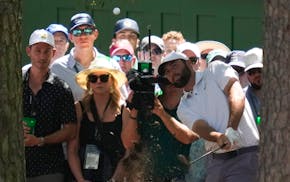In 1966, The Standells released a single titled "Dirty Water," about Boston's filthy harbor. The song became the city's sports anthem and foreshadowed decades of Massachusetts malfeasance. The Boston sports mascot should be Whitey Bulger.
Bill Belichick has defied or bent NFL rules, and last week the New York Times reported that the Boston Red Sox used Apple watches and television broadcasts — maybe the "Seinfeld" season during which George Costanza works for the Yankees? — to steal signs from New York during games at Fenway Park.
Leave it to a team from Boston to decide that stealing signs the old-fashioned way wasn't efficient enough.
The Red Sox made a dire mistake, and the mistake wasn't cheating. The mistake was using modern technology to cheat. That is against baseball's rules, and that's what transformed this episode from quaint to criminal.
Baseball has always tolerated, if not encouraged, cheating that falls under the category of gamesmanship. If you don't believe me, ask the Twins manager.
When he played, Paul Molitor and Brewers teammate Robin Yount were considered among the best sign stealers in the game. When they reached second base, they'd figure out the catcher's signals and notify the batter of the type of pitch or its intended location with their own signals, often picking at different locations on their uniform.
That kind of sign stealing doesn't incur the wrath of Major League Baseball. But if you got caught, in those days, you'd probably be ducking a fastball your next time at the plate.
When Molitor worked with Twins minor leaguers in his previous job, he would sit in the dugout, observe the opposing pitcher and be able to predict every pitch within an inning or two.
Baseball culture not only doesn't mind that kind of sign-stealing, baseball culture celebrates that kind of ingenuity.
Which is why the Red Sox were more stupid than evil. Using television cameras and a high-tech watch probably didn't help them markedly more than old-fashioned sign stealing would have. The Sox jeopardized the franchise's reputation and risked penalty trying to be clever, when truly clever players have been stealing signs effectively for a century or more.
The most famous case of baseball thievery occurred during one of baseball's most famous games. According to a 2001 story by Josh Prager in the Wall Street Journal, the New York Giants spied on the opposing catcher with a telescope from the outfield and used a wire and a series of buzzes to signal the nature of upcoming pitches to the bullpen, which would signal the batter.
There have been great hitters who have ordered teammates not to "tip" pitches, either because they didn't think they needed the help or didn't trust their teammates to interpret the signals correctly.
Former Twins All-Star Roy Smalley said that former Twins coach Joe Nossek was an expert sign stealer. He would steal them from the opposing catcher while watching from the coach's box, and he would study pitcher tendencies.
Twins star Torii Hunter would do the same using video, studying opposing pitchers until he could predict by flutter of glove or body movement what pitch was coming next. There is at least one current Twins player who learned from Hunter and Molitor and studies video to the same effect.
Smalley said that former Twins manager Gene Mauch ranked among the best sign stealers he ever encountered. Smalley wasn't bad himself.
In 1981, Smalley faced a pitcher named Bill Travers in Anaheim. Smalley had noted that when Travers threw his split-fingered changeup, he would move his hand as he started his windup in a way that caused the glove to flap.
Smalley wanted to hit the fastball, not the change. When he saw Travers' glove remain still, he knew he was getting a fastball and he hit a grand slam to win the game.
Smalley hates technological sign stealing. He hopes the Red Sox are punished.
As for those who steal signs the old-fashioned way, Smalley said, "That's the way the game is played."
Jim Souhan's podcast can be heard at MNSPN.com. On Twitter: @SouhanStrib. • jsouhan@startribune.com

Souhan: Why Tiger Woods should keep swinging
Souhan: Scheffler wins Masters again, shows what makes him special
Morikawa falters in final round at Masters

Keeping up with the Joneses who helped design Augusta National's classic back nine


